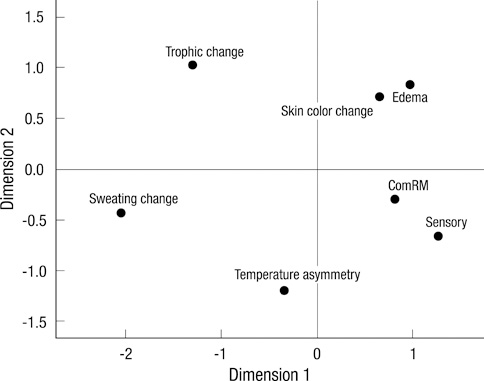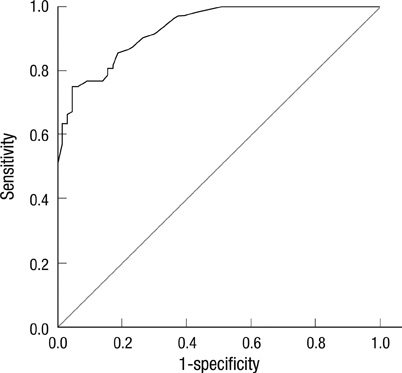J Korean Med Sci.
2011 Apr;26(4):568-573. 10.3346/jkms.2011.26.4.568.
Proposing a Scoring System for the Research Criteria of Complex Regional Pain Syndrome
- Affiliations
-
- 1Department of Anesthesiology and Pain Medicine, Chungbuk National University Hospital, Jeongju, Korea.
- 2Department of Anesthesiology and Pain Medicine, Seoul National University College of Medicine, Seoul, Korea. soo02@snu.ac.kr
- 3Department of Anesthesiology and Pain Medicine, Seoul National University Bundang Hospital, Seongnam, Korea.
- KMID: 1777889
- DOI: http://doi.org/10.3346/jkms.2011.26.4.568
Abstract
- This study evaluated the structure of complex regional pain syndrome (CRPS) population and suggested a weighted scoring system to balance on objective signs. One hundred sixty-eight consecutive patients were evaluated using the Budapest Research Criteria (BRC). By using multidimensional scaling and logistic regression analysis, we analyzed the degree of importance and relationships between objective findings. In addition, a receiver operating characteristic curve was constructed using a weighted score derived from the risk ratio as a diagnostic test. There were correlations between skin color change and edema, and between decreased range of motion and motor dysfunction when multidimensional scaling was applied. The trophic change was excluded by a logistic regression (95% CI; 0.80-11.850). The cutoff point based on weighted score derived from the risk ratios for determining CRPS was 7.88. At this point, the sensitivity, specificity, positive predictive value and negative predictive value were 75.0%, 95.3%, 96.3%, and 70.1%, respectively. We propose a weighted scoring system for the BRC using risk ratios of objective signs. Although a thorough systematic review would be required in the future, this study can contribute to reduction of the possible distortion of the feature of CRPS populations by the BRC.
MeSH Terms
Figure
Reference
-
1. Stanton-Hicks M, Jänig W, Hassenbusch S, Haddox JD, Boas R, Wilson P. Reflex sympathetic dystrophy: changing concepts and taxonomy. Pain. 1995. 63:127–133.2. Bruehl S, Harden RN, Galer BS, Saltz S, Backonja M, Stanton-Hicks M. Complex regional pain syndrome: are there distinct subtypes and sequential stages of the syndrome? Pain. 2002. 95:119–124.3. Park SG, Hyun JK, Lee SJ, Jeon JY. Quantitative evaluation of very acute stage of complex regional pain syndrome after stroke using three-phase bone scintigraphy. Nucl Med Commun. 2007. 28:766–770.4. de Mos M, de Bruijn AG, Huygen FJ, Dieleman JP, Stricker BH, Sturkenboom MC. The incidence of complex regional pain syndrome: a population-based study. Pain. 2007. 129:12–20.5. Dommerholt J. Complex regional pain syndrome-1: history, diagnostic criteria and etiology. J Bodyw Mov Ther. 2004. 8:167–177.6. Harden RN, Bruehl S, Galer BS, Saltz S, Bertram M, Backonja M, Gayles R, Rudin N, Bhugra MK, Stanton-Hicks M. Complex regional pain syndrome: are the IASP diagnostic criteria valid and sufficiently comprehensive? Pain. 1999. 83:211–219.7. van de Vusse AC, Stomp-van den Berg SG, de Vet HC, Weber WE. Interobserver reliability of diagnosis in patients with complex regional pain syndrome. Eur J Pain. 2003. 7:259–265.8. Schürmann M, Zaspel J, Löhr P, Wizgall I, Tutic M, Manthey N, Steinborn M, Gradl G. Imaging in early posttraumatic complex regional pain syndrome: a comparison of diagnostic methods. Clin J Pain. 2007. 23:449–457.9. Pankaj A, Kotwal PP, Mittal R, Deepak KK, Bal CS. Diagnosis of post-traumatic complex regional pain syndrome of the hand: current role of sympathetic skin response and three-phase bone scintigraphy. J Orthop Surg (Hong Kong). 2006. 14:284–290.10. Harden RN, Bruehl SP. Diagnosis of complex regional pain syndrome: signs, symptoms, and new empirically derived diagnostic criteria. Clin J Pain. 2006. 22:415–419.11. Harden RN, Bruehl S, Stanton-Hicks M, Wilson PR. Proposed new diagnostic criteria for complex regional pain syndrome. Pain Med. 2007. 8:326–331.12. Birklein F, Künzel W, Sieweke N. Despite clinical similarities there are significant differences between acute limb trauma and complex regional pain syndrome I (CRPS I). Pain. 2001. 93:165–171.13. Daviet JC, Preux PM, Salle JY, Lebreton F, Munoz M, Dudognon P, Pelissier J, Perrigot M. Clinical factors in the prognosis of complex regional pain syndrome type I after stroke: a prospective study. Am J Phys Med Rehabil. 2002. 81:34–39.14. Mittenberg W, Patton C, Canyock EM, Condit DC. Base rates of malingering and symptom exaggeration. J Clin Exp Neuropsychol. 2002. 24:1094–1102.15. Taskaynatan MA, Balaban B, Karlidere T, Ozgul A, Tan AK, Kalyon TA. Factitious disorders encountered in patients with the diagnosis of reflex sympathetic dystrophy. Clin Rheumatol. 2005. 24:521–526.16. Kim YC, Bahk JH, Lee SC, Lee YW. Infrared thermographic imaging in the assessment of successful block on lumbar sympathetic ganglion. Yonsei Med J. 2003. 44:119–124.17. Chang JS, Ahn YM, Yu HY, Park HJ, Lee KY, Kim SH, Kim YS. Exploring clinical characteristics of bipolar depression: internal structure of the bipolar depression rating scale. Aust N Z J Psychiatry. 2009. 43:830–837.18. Zhang J, Yu KF. What's the relative risk? A method of correcting the odds ratio in cohort studies of common outcomes. JAMA. 1998. 280:1690–1691.19. Beaudeau F, Fourichon C. Estimating relative risk of disease from outputs of logistic regression when the disease is not rare. Prev Vet Med. 1998. 36:243–256.20. Niehof SP, Beerthuizen A, Huygen FJPM, Zijlstra FJ. Using skin surface temperature to differentiate between complex regional pain syndrome type 1 patients after a fracture and control patients with various complaints after a fracture. Anesth Analg. 2008. 106:270–277.21. Schwartzman RJ, Erwin KL, Alexander GM. The natural history of complex regional pain syndrome. Clin J Pain. 2009. 25:273–280.22. Sandroni P, Benrud-Larson LM, McClelland RL, Low PA. Complex regional pain syndrome type I: incidence and prevalence in Olmsted county, a population-based study. Pain. 2003. 103:199–207.23. Allen G, Galer BS, Schwartz L. Epidemiology of complex regional pain syndrome: a retrospective chart review of 134 patients. Pain. 1999. 80:539–544.24. Choi YS, Lee MG, Lee HM, Lee CJ, Jo JY, Jeon SY, Lee SC, Kim YC. Epidemiology of complex regional pain syndrome: a retrospective chart review of 150 Korean patients. J Korean Med Sci. 2008. 23:772–775.25. Bruehl S, Harden RN, Galer BS, Saltz S, Bertram M, Backonja M, Gayles R, Rudin N, Bhugra MK, Stanton-Hicks M. External validation of IASP diagnostic criteria for Complex Regional Pain Syndrome and proposed research diagnostic criteria. Pain. 1999. 81:147–154.



